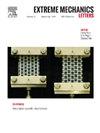Ratcheting induced crack growth in semiconductor devices
IF 4.5
3区 工程技术
Q2 MATERIALS SCIENCE, MULTIDISCIPLINARY
引用次数: 0
Abstract
Semiconductor devices integrate dissimilar materials, including semiconductors, ceramics, metals, and polymers. These materials have different coefficients of thermal expansion, so that the devices develop stresses when temperature changes. Here we study a failure mode caused by cyclic changes in temperature. Under certain conditions, thermal cycling causes a metal to accumulate plastic deformation cycle by cycle, a phenomenon called ratcheting. The ratcheting in the metal can drive a crack to grow in a nearby brittle material. We simulate a representative structure using the finite element method. As the temperature cycles, the plastic deformation in the metal ratchets, and the energy release rate of the crack in the brittle material increases. After a large number of temperature cycles, the metal no longer ratchets, and the energy release rate plateaus. We find that this plateau is well approximated by the energy release rate in a structure where the metal is replaced by a void, calculated by a monotonic change in temperature. This simplification reduces computational cost for modeling ratcheting induced cracking. We also examine the effects of material and geometric parameters. It is hoped that this study will aid the design of semiconductor devices.
半导体器件中棘轮引起的裂纹扩展
半导体器件集成了不同的材料,包括半导体、陶瓷、金属和聚合物。这些材料具有不同的热膨胀系数,因此当温度变化时,器件会产生应力。本文研究了温度循环变化引起的失效模式。在一定条件下,热循环使金属一个周期一个周期地积累塑性变形,这种现象称为棘轮。金属中的棘轮可以驱动裂纹在附近的脆性材料中生长。我们用有限元法模拟了一个有代表性的结构。随着温度的循环,金属中的塑性变形呈棘轮状,脆性材料中裂纹的能量释放率增大。经过大量的温度循环后,金属不再棘轮,能量释放率趋于平稳。我们发现这个平台很好地近似于在金属被空洞取代的结构中的能量释放率,用温度的单调变化来计算。这种简化减少了模拟棘轮诱导开裂的计算成本。我们还研究了材料和几何参数的影响。希望本研究能对半导体器件的设计有所帮助。
本文章由计算机程序翻译,如有差异,请以英文原文为准。
求助全文
约1分钟内获得全文
求助全文
来源期刊

Extreme Mechanics Letters
Engineering-Mechanics of Materials
CiteScore
9.20
自引率
4.30%
发文量
179
审稿时长
45 days
期刊介绍:
Extreme Mechanics Letters (EML) enables rapid communication of research that highlights the role of mechanics in multi-disciplinary areas across materials science, physics, chemistry, biology, medicine and engineering. Emphasis is on the impact, depth and originality of new concepts, methods and observations at the forefront of applied sciences.
 求助内容:
求助内容: 应助结果提醒方式:
应助结果提醒方式:


